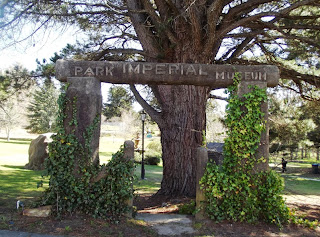UNCONFORMITY AT SOUTH BOWENFELS NEAR LITHGOW NEW SOUTH WALES AUSTRALIA
 |
| Aplite dyke intruding granite (very weathered) |
This is the first purely geological entry I’ve
written for this Blog. Most readers will be familiar with the basic geology of
the western Blue Mountains. Essentially, there is a series of sedimentary rocks
resting on an eroded surface of older rocks, both igneous and sedimentary. The
rocks that we see from lookouts such as Echo Point or Govett’s Leap consist of Triassic sandstones and siltstones (the
Narrabeen Group, which forms the
cliffs) and the Permian Illawarra Coal
Measures (nonmarine) and Shoalhaven
Group (marine) which form the slopes and more level areas below.
Once Victoria Pass is descended into the Hartley
Valley, there comes a point near Hartley where the Permian Shoalhaven Group
sedimentary rocks gives way to the underlying granite, which occupies the lower ground. The sedimentary rocks and
the granite are of quite different ages, Permian
and Lower Carboniferous
respectively, and the surface between them is called an unconformity (a time gap).
 |
| Shoalhaven Group conglomerate overlying weathered granite |
At the very least, the time gap
represented by this unconformity covers the time involved in forming the
granite (as an intrusion into even older rocks), uplifting the earth’s crust
and eroding away the overlying rocks and deeply weathering the now exposed
granite.
At this point in time the Sydney Basin began to form as the land subsided. The first
sediments deposited in this vast subsiding area were the marine sandstones,
conglomerates and siltstones of the Shoalhaven Group. These contain lots of
pebbles (sometimes boulders) of the more resistant older local rocks. Most of
these consist of hard quartzite, evidently derived from the nearby Upper Devonian Rydal Syncline.
 |
| Detail of the unconformity |
It’s not often you can put your finger on an
unconformity like this, representing as it does perhaps 100 million years of
time. The geological map is a small portion of one published in 1875 (see
below). The excavation where the photographs were taken is in Portion 241. You
can read the notes (21 and 22) which accompany the map. I have yet to find any
pebbles containing Upper Devonian marine fossils nor any Permian marine fossils
in the Shoalhaven Group sediments, but these are well known from other nearby
localities. The cross section from the Sydney 1:250 000 geological map goes
right through this spot and clearly shows the relationship between the various
rocks.
 | |
| A large quartzite cobble from the conglomerate. |
References:
“Geological Map of the Districts of
Hartley, Bowenfells, Wallerawang and Rydal” (Department of Mines, New South
Wales, 1875). The DIGS reference is Heritage Map H0252. Geological
Map of Sydney 3rd edition 1966. The DIGS reference simply says “Map”, so try using the Report Identification
Number R00019218 instead.
https://johnsbluemountainsblog.blogspot.com/2013/12/links-to-all-blog-entries-and-relevant.html All Blue Mountains blogs and videos
All New England and other Geology blogs and videos
Limestone Caves of NSW
Song Studies. Bible studies based on hymns and songs
Shoalhaven District Geology.


























